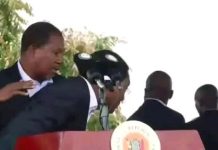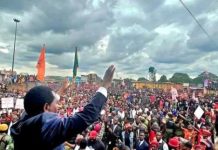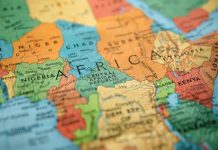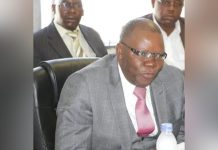Africa-Press – Zambia. MONITOR | Chingola Disruption Sparks Questions Over Crowd Control and Intelligence Gaps
The disruption of President Hakainde Hichilema’s address this afternoon at Chiwempala Market has ignited sharp debate across social media, splitting reactions between those who downplay the incident and those who believe the chaos was engineered. What was meant to be a routine reassurance visit after the market fire turned into a short and chaotic interruption that has now raised broader questions about security planning and political manipulation.
The President had spoken for less than three minutes when a small cluster in the crowd broke the rhythm of the event with chants of “Senseli, Senseli.” Stones followed. Security personnel reacted in seconds and pulled the President out of the speaking position. The rapid extraction showed disciplined tactical response, but the breach itself exposed a lapse in pre-event scanning and behavioural profiling. A presidential site requires layered control: close protection, crowd zoning, tactical surveillance and soft-spot inoculation. Something in that chain failed.
Online discussion shows two dominant narratives. The UPND base insists the incident was minor, created by a handful of disruptive individuals and amplified for political mileage. Opposition supporters present it as evidence of declining grassroots confidence and see the “Senseli” chants as a political message rather than random disorder. Both sides read the moment through partisan filters, yet the operational facts suggest deeper structural questions.
One of those questions concerns intelligence posture. The event appeared spontaneous on camera, but footage circulating online shows coordinated chanting patterns and individuals moving together before the disruption. That behaviour points to pre-event organisation rather than isolated anger. Intelligence units are expected to identify such clusters through reconnaissance, listening posts and community indicators before the President arrives. Analysts now point to a possible intelligence miss, particularly given Chingola’s recent political volatility.
Another layer is the crowd pressure along the President’s movement route. Videos show a dense mass of supporters blocking parts of the motorcade and prompting the President to step out and greet them. This is a high-risk moment in any security operation. A stopped motorcade creates a static target. The protective formation loses mobility advantage. The crowd gains psychological and physical leverage. That the scene unfolded without incident was due more to the goodwill of the crowd than to secure operating conditions.
The political class is also reading the pictures closely. Opposition voices frame the incident as a signal of frustration in the Copperbelt and argue that public sentiment is hardening over load-shedding and cost-of-living pressure. UPND voices argue the President was received by a large and positive community, and that the disruption was a manufactured stunt designed to overshadow the broader welcome. The footage supports both readings: a large crowd, and a small disruptive cell working with intent.
The unanswered question is how such a cell entered a controlled zone with stones. Markets are difficult environments for presidential events because supply routes and side-paths give room for unfiltered entry. Even so, standard presidential advance teams secure perimeters, sweep access points and manage screening lines to prevent exactly this type of breach. The lapse now raises operational questions for the security cluster and the intelligence service.
What remains clear is that this was not a collapse of public order but a reminder of how quickly a presidential event can turn. The President left safely. The crowd dispersed. The message of relief for traders was overshadowed. The political conversation has shifted to security gaps and crowd intent. Our monitoring will continue to track the online footprint, the political responses and the intelligence posture as Chingola becomes a test case of presidential security under strained public sentiment.
⬆️ Editor’s Note:
Our MONITOR features track emerging political temperature through field footage, digital sentiment tools and movement analysis. The aim is to give readers context that sits behind the noise and ahead of official statements.
© The People’s Brief | Ollus R. Ndomu
For More News And Analysis About Zambia Follow Africa-Press







